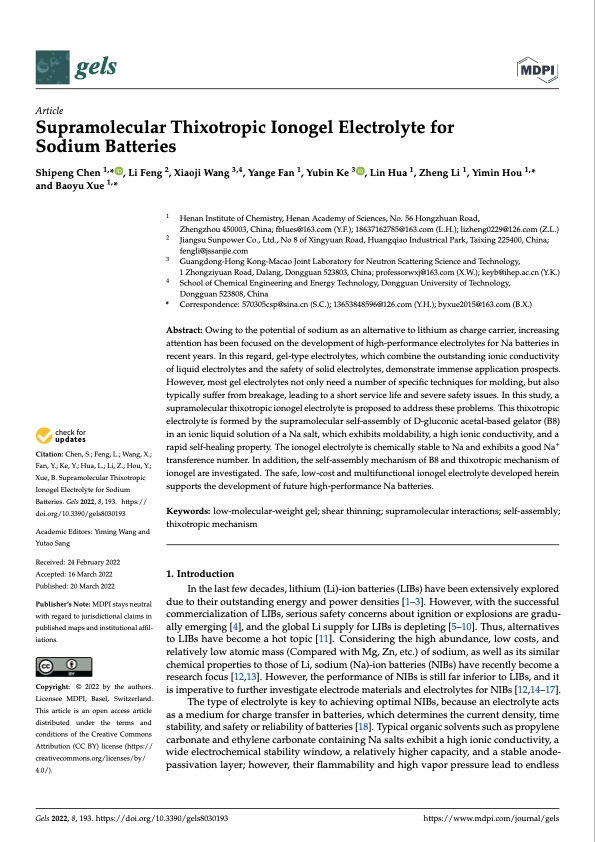
PDF Publication Title:
Text from PDF Page: 001
gels Article Supramolecular Thixotropic Ionogel Electrolyte for Sodium Batteries Shipeng Chen 1,* and Baoyu Xue 1,* , Li Feng 2, Xiaoji Wang 3,4, Yange Fan 1, Yubin Ke 3 , Lin Hua 1, Zheng Li 1, Yimin Hou 1,* Citation: Chen, S.; Feng, L.; Wang, X.; Fan, Y.; Ke, Y.; Hua, L.; Li, Z.; Hou, Y.; Xue, B. Supramolecular Thixotropic Ionogel Electrolyte for Sodium Batteries.Gels2022,8,193. https:// doi.org/10.3390/gels8030193 Academic Editors: Yiming Wang and Yutao Sang Received: 24 February 2022 Accepted: 16 March 2022 Published: 20 March 2022 Publisher’s Note: MDPI stays neutral with regard to jurisdictional claims in published maps and institutional affil- iations. Copyright: © 2022 by the authors. Licensee MDPI, Basel, Switzerland. This article is an open access article distributed under the terms and conditions of the Creative Commons Attribution (CC BY) license (https:// creativecommons.org/licenses/by/ 4.0/). 1 2 3 4 * Correspondence: 570305csp@sina.cn (S.C.); 13653848596@126.com (Y.H.); byxue2015@163.com (B.X.) Abstract: Owing to the potential of sodium as an alternative to lithium as charge carrier, increasing attention has been focused on the development of high-performance electrolytes for Na batteries in recent years. In this regard, gel-type electrolytes, which combine the outstanding ionic conductivity of liquid electrolytes and the safety of solid electrolytes, demonstrate immense application prospects. However, most gel electrolytes not only need a number of specific techniques for molding, but also typically suffer from breakage, leading to a short service life and severe safety issues. In this study, a supramolecular thixotropic ionogel electrolyte is proposed to address these problems. This thixotropic electrolyte is formed by the supramolecular self-assembly of D-gluconic acetal-based gelator (B8) in an ionic liquid solution of a Na salt, which exhibits moldability, a high ionic conductivity, and a rapid self-healing property. The ionogel electrolyte is chemically stable to Na and exhibits a good Na+ transference number. In addition, the self-assembly mechanism of B8 and thixotropic mechanism of ionogel are investigated. The safe, low-cost and multifunctional ionogel electrolyte developed herein supports the development of future high-performance Na batteries. Keywords: low-molecular-weight gel; shear thinning; supramolecular interactions; self-assembly; thixotropic mechanism 1. Introduction In the last few decades, lithium (Li)-ion batteries (LIBs) have been extensively explored due to their outstanding energy and power densities [1–3]. However, with the successful commercialization of LIBs, serious safety concerns about ignition or explosions are gradu- ally emerging [4], and the global Li supply for LIBs is depleting [5–10]. Thus, alternatives to LIBs have become a hot topic [11]. Considering the high abundance, low costs, and relatively low atomic mass (Compared with Mg, Zn, etc.) of sodium, as well as its similar chemical properties to those of Li, sodium (Na)-ion batteries (NIBs) have recently become a research focus [12,13]. However, the performance of NIBs is still far inferior to LIBs, and it is imperative to further investigate electrode materials and electrolytes for NIBs [12,14–17]. The type of electrolyte is key to achieving optimal NIBs, because an electrolyte acts as a medium for charge transfer in batteries, which determines the current density, time stability, and safety or reliability of batteries [18]. Typical organic solvents such as propylene carbonate and ethylene carbonate containing Na salts exhibit a high ionic conductivity, a wide electrochemical stability window, a relatively higher capacity, and a stable anode- passivation layer; however, their flammability and high vapor pressure lead to endless Henan Institute of Chemistry, Henan Academy of Sciences, No. 56 Hongzhuan Road, Zhengzhou 450003, China; fblues@163.com (Y.F.); 18637162785@163.com (L.H.); lizheng0229@126.com (Z.L.) Jiangsu Sunpower Co., Ltd., No 8 of Xingyuan Road, Huangqiao Industrical Park, Taixing 225400, China; fengli@jssanjie.com Guangdong-Hong Kong-Macao Joint Laboratory for Neutron Scattering Science and Technology, 1 Zhongziyuan Road, Dalang, Dongguan 523803, China; professorwxj@163.com (X.W.); keyb@ihep.ac.cn (Y.K.) School of Chemical Engineering and Energy Technology, Dongguan University of Technology, Dongguan 523808, China Gels 2022, 8, 193. https://doi.org/10.3390/gels8030193 https://www.mdpi.com/journal/gelsPDF Image | Thixotropic Ionogel Electrolyte for Sodium Batteries

PDF Search Title:
Thixotropic Ionogel Electrolyte for Sodium BatteriesOriginal File Name Searched:
gels-08-00193-v2.pdfDIY PDF Search: Google It | Yahoo | Bing
Product and Development Focus for Salgenx
Redox Flow Battery Technology: With the advent of the new USA tax credits for producing and selling batteries ($35/kW) we are focussing on a simple flow battery using shipping containers as the modular electrolyte storage units with tax credits up to $140,000 per system. Our main focus is on the salt battery. This battery can be used for both thermal and electrical storage applications. We call it the Cogeneration Battery or Cogen Battery. One project is converting salt (brine) based water conditioners to simultaneously produce power. In addition, there are many opportunities to extract Lithium from brine (salt lakes, groundwater, and producer water).Salt water or brine are huge sources for lithium. Most of the worlds lithium is acquired from a brine source. It's even in seawater in a low concentration. Brine is also a byproduct of huge powerplants, which can now use that as an electrolyte and a huge flow battery (which allows storage at the source).We welcome any business and equipment inquiries, as well as licensing our flow battery manufacturing.| CONTACT TEL: 608-238-6001 Email: greg@salgenx.com | RSS | AMP |